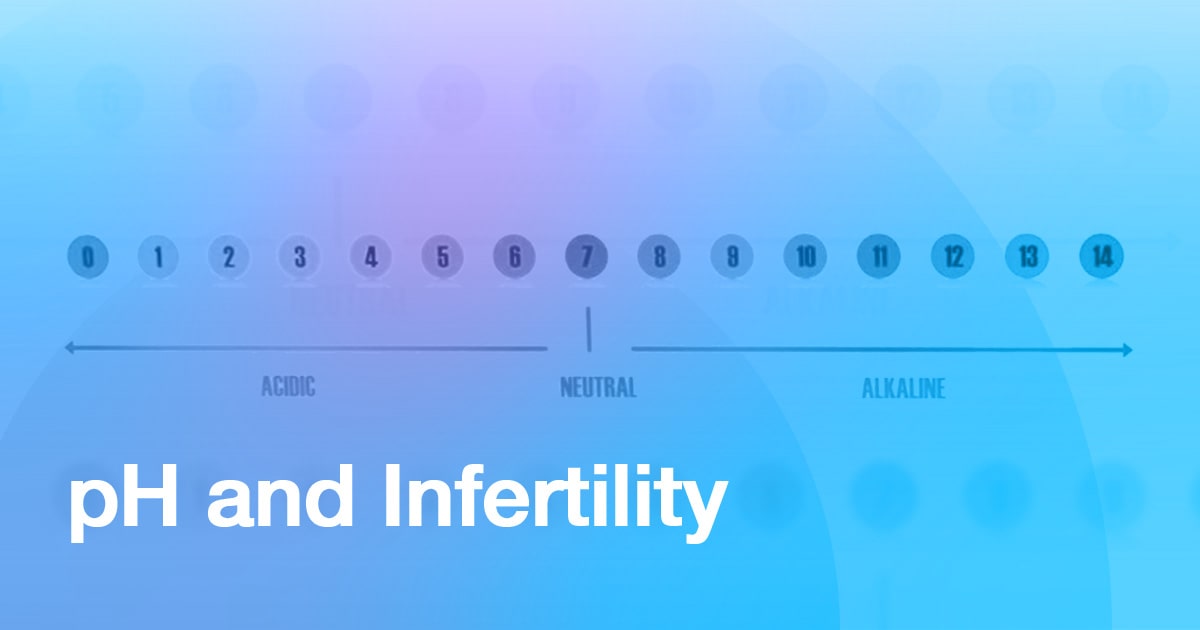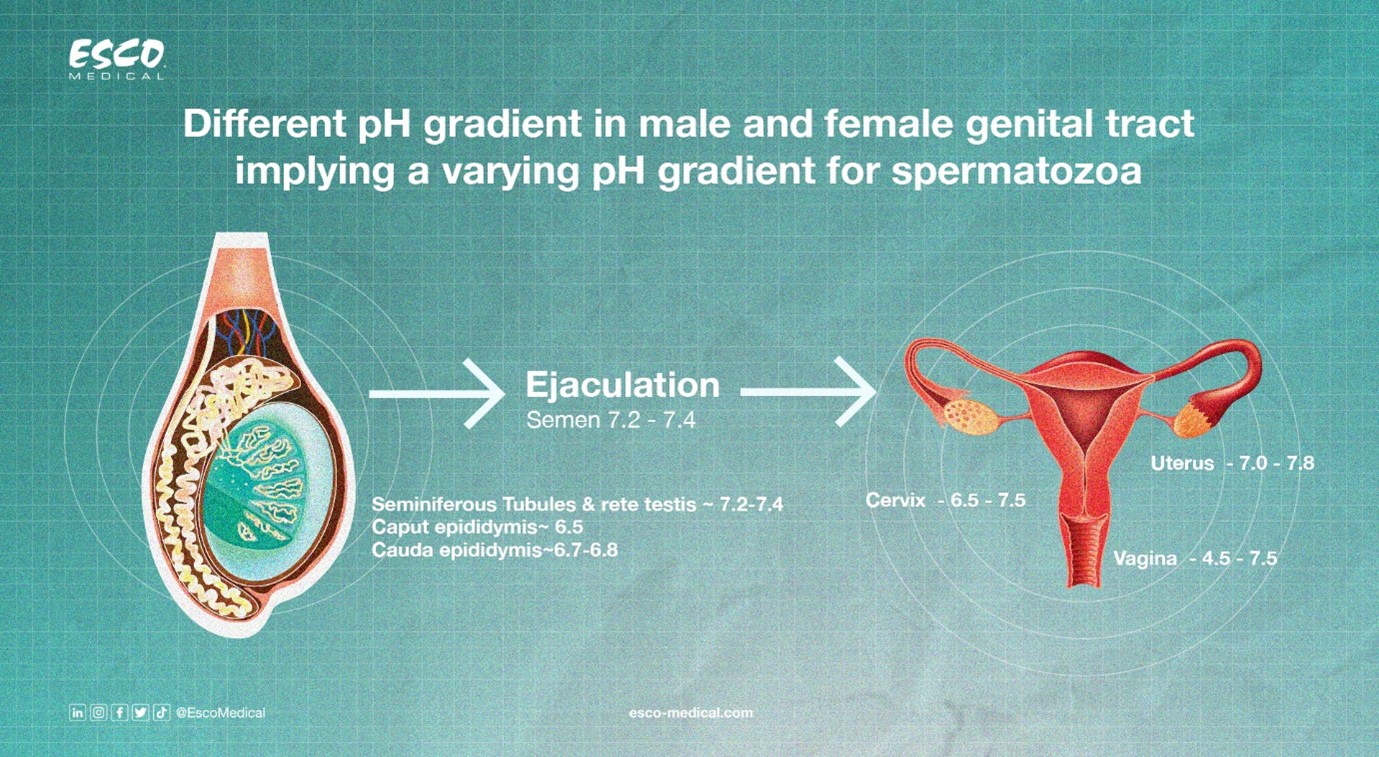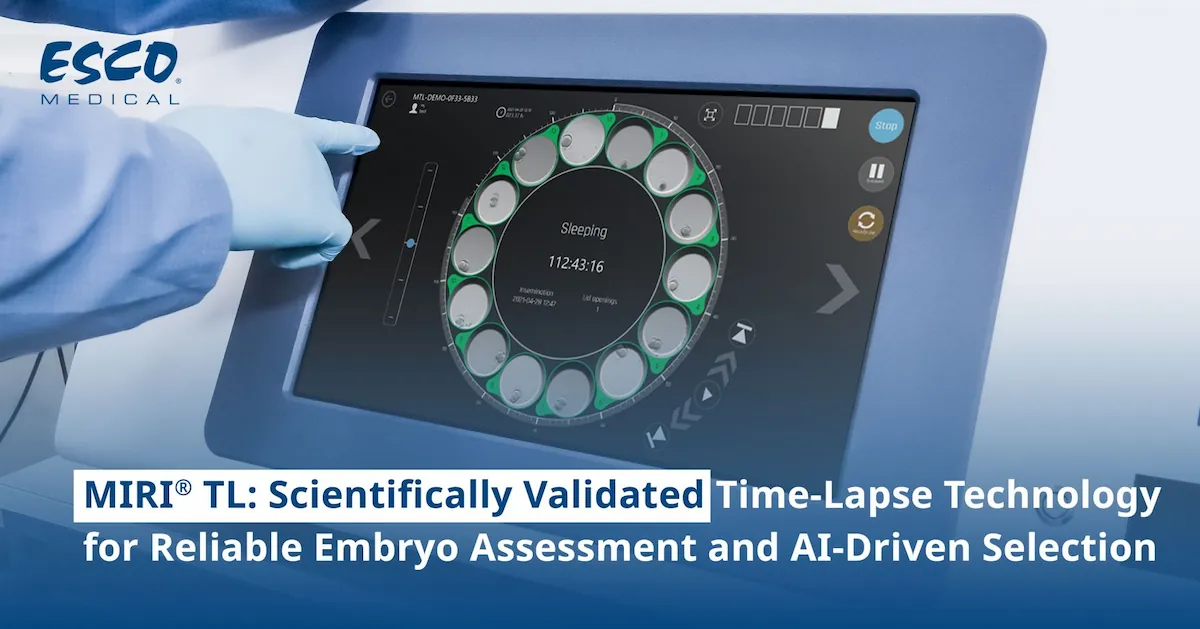
What is the importance of pH in-vivo?
One of the main objectives for an embryologist is to enhance the quality of embryos as they develop in the laboratory. A crucial aspect of accomplishing this goal involves reducing the stresses exerted on gametes and embryos during their handling within the in-vitro environment. pH, a particular environmental factor, demands meticulous control of its set-point due to its susceptibility to detrimental fluctuations (Swain, 2010).
Spermatozoa are enveloped in seminal plasma, a complex fluid comprised of secretions from the accessory sex glands of the male reproductive system. This fluid potentially contains all the active components necessary for optimal regulation of pH in and around sperm cells (Mishra,2018).

Variations in Semen pH in-vivo:
- In the seminiferous tubules and rete testis of mammals, sperm cells encounter a pH range of 7.2-7.4.
- This pH shifts to 6.5 in the caput epididymis and 6.7-6.8 in the cauda epididymis.
- During ejaculation, the pH of semen becomes 7.2-7.4.
- After ejaculation into the vagina, the pH ranges from 4.5 to 7.5.
- In the cervix, the pH increases to 6.5-7.5, and ultimately, in the uterus and fallopian tube, it reaches 7-7.8.
- Spermatozoa are highly influenced by pH, with functions such as motility, viability, capacitation, and acrosome reaction being pH dependent (Mishra, 2018).
- The reported pH of follicular fluid is 7.2–7.3(Ng, 2017)
- The naturally acidic vaginal fluid serves a bactericidal function, protecting the cervical canal from pathogenic organisms. Within about 10 seconds, the pH of the upper vagina increases from 4.3 to as much as 7.2. Although the buffering effect lasts only a few minutes in humans, it provides sufficient time for spermatozoa to approach the cervix in an environment with an optimal pH for sperm motility pH 6.0–6.5(Nakano, 2015); (Gamete Transport, 2014); (Carlson, 2019).
Variations in Semen pH in-vitro:
- In laboratory settings, biological pH buffers have been incorporated into culture media for embryos to stabilize pH and reduce harmful intracellular variations resulting from pH fluctuations in human pre-implantation embryos. (Ng, 2017); (Will, 2011)
Effect of fluctuations in pH:
- An acidic ejaculate with a pH below 7.2 could indicate a blockage of seminal vesicles, while an alkaline pH of approximately 8.0 is commonly associated with infections. Various inflammatory conditions, particularly those affecting the prostate or seminal vesicles, as well as agenesis of the vas deferens and seminal vesicles, may lead to pH values that deviate from the normal range (Dhumal, 2021).
- The elevated pH of semen serves as a protective measure for sperm in an acidic environment. Insufficient semen volume or reduced alkalinity of seminal vesicular fluid can impact buffering capacity, potentially leading to compromised fertility. Maintaining an optimal pH in the diluent is crucial for supporting sperm respiration and motility (Mishra,2018). Hence, during in vitro sperm storage, semen diluents are incorporated to provide iso-osmotic conditions, maintain relatively constant physico-chemical stability for sperm, ensure nearly neutral pH, and supply suitable energy substrates (Bonato, 2012). In order to mitigate pH fluctuations, buffering agents are introduced into diluents. Consequently, inadequate pH control during the freezing process could negatively impact the effectiveness of Artificial Insemination (AI).
- Microbial contamination leads to a decrease in the pH of diluents, and this pH alteration adversely affects the overall quality of sperm cells. Research indicates a substantial decline in sperm motility and viability in acidic pH conditions resulting from microbial contamination. The low pH also contributes to a diminished post-thaw quality of spermatozoa, resulting in poor or compromised conception rates (Mishra,2018).
Human sperm internal and external pH:
The pH may exert a significant initial influence on sperm activity and motility both before and during the fertilization process (J.E, 2012).
- Internal pH (pHi):
The internal pH (pHi) of human sperm has been documented within the range of approximately 6.5 to 6.9. While sperm seem to possess certain regulators for pHi, the external pH (pHe) can influence the pHi in sperm, including that of humans. In this context, a linear relationship exists, and the pHi is 0.4 units lower than the pHe.
- External pH (pHe):
The cellular environment's pH (pHe) is determined by the equilibrium between CO2 concentrations in the cell culture incubator and the quantity of bicarbonate in the media. Consequently, regulating pHe is a vital environmental variable to manage in the IVF lab, particularly for cells sensitive to pHe, such as sperm, denuded mature oocytes, and cryopreserved/thawed embryos (J.E, 2012); (Darszon, 1999).
According to various studies, it has been proposed that spermatozoa maintain their functionality in the female reproductive tract for approximately 80 hours (Gamete Transport, 2014). In contrast, spermatozoa ejaculated and preserved in vitro exhibit lower survival rates compared to those retained in the female genital tract. The natural pH of the vagina, which is around 4, possesses inherent spermicidal and microbicidal properties. Therefore, if semen lacks a robust alkaline buffering capacity, sperm may struggle to endure in the vaginal environment (Olmsted, 2000).
For successful in vivo fertilization, it is imperative that sperm exhibit good quality, with more than 40% classified as fast progressive motile sperms (Natarajamani, 2014). Seminal plasma, originating from the seminal vesicles, prostate, and bulbourethral glands, contributes to optimal pH, viscosity, nutrition, and a substantial portion of antioxidants within the semen, supporting the viability of spermatozoa. In vitro incubation of sperm in the absence of seminal plasma leads to a significant rise in oxidative stress markers and a corresponding decrease in motility after 2 hours (Wagner, 2018).
The viability of sperm during extended incubation is significantly influenced by both the composition of the medium and the gaseous environment to which the sperm are exposed. It is clear, that the seminal fluid is not favourable for the prolonged incubation of sperm under any circumstances (Makler, 1984).
Conclusion:
Sperm, uniquely situated outside the male body, is notably influenced by pH, exerting a significant impact on its activity and motility both before and during fertilization. Key sperm functions, including motility, viability, capacitation, and acrosome reaction, are contingent upon pH levels. Throughout the male and female genital tracts, sperm cells exhibit precise regulation of proton gradients and, consequently, intracellular pH. Maintaining optimal sperm viability and motility requires a vaginal pH ranging from 7.0 to 8.5, with reduced motility observed below a pH of 6.0. Although the alkaline pH of semen offers temporary protection, diminished semen volume and/or reduced alkaline seminal vesicular secretion may adversely affect fertility by compromising semen's buffering capacity against vaginal acidity.
References:
- Bonato, M., Cornwallis, C. K., Malecki, I. A., Rybnik-Trzaskowska, P. K., & Cloete, S. W. P. (2012). The effect of temperature and pH on the motility and viability of ostrich sperm. Animal Reproduction Science, 133(1-2), 123–128.
- Carlson, B. M. (2019). The Reproductive System. The Human Body, 373–396.
- Gamete Transport. (2014). Reference Module in Biomedical Sciences.
- Makler, A., Fisher, M., Murillo, O., Laufer, N., DeCherney, A., & Naftolin, F. (1984). Factors affecting sperm motility. IX. Survival of spermatozoa in various biological media and under different gaseous compositions. Fertility and Sterility, 41(3), 428–432.Mishra, A. K., Kumar, A., Swain, D. K., Yadav, S., & Nigam, R. (2018). Insights into pH regulatory mechanisms in mediating spermatozoa functions. Veterinary world, 11(6), 852–858.
- Nakano, F. Y., Leão, R. de B. F., & Esteves, S. C. (2015). Insights into the role of cervical mucus and vaginal pH in unexplained infertility. Medical Express, 2(2).
- Natarajamani, S., MedSci, M., Janani, D., Tech, M., Subramanian, M., & Manikere, A. (2014). Correlation of Semen pH with other Semen Parameters in a Sub fertile male Population Attending a Tertiary ART center in South India.
- Ng, K. Y. B., Mingels, R., Morgan, H., Macklon, N., & Cheong, Y. (2017). In vivo oxygen, temperature and pH dynamics in the female reproductive tract and their importance in human conception: a systematic review. Human Reproduction Update, 24(1), 15–34.
- Nishigaki, T., José, O., González-Cota, A. L., Romero, F., Treviño, C. L., & Darszon, A. (2014). Intracellular pH in sperm physiology. Biochemical and biophysical research communications, 450(3), 1149–1158.
- Olmsted, S. S., Dubin, N. H., Cone, R. A., & Moench, T. R. (2000). The rate at which human sperm are immobilized and killed by mild acidity. Fertility and Sterility, 73(4), 687–693.Swain J. E. (2012). Is there an optimal pH for culture media used in clinical IVF? Human reproduction update, 18(3), 333–339.
- Dumal S., & Sullia, K. (2021). Semen pH and its correlation with motility and count - A study in subfertile men. JBRA assisted reproduction, 25(2), 172–175.
- Mishra, A. K., Kumar, A., Swain, D. K., Yadav, S., & Nigam, R. (2018). Insights into pH regulatory mechanisms in mediating spermatozoa functions. Veterinary world, 11(6), 852–858.





